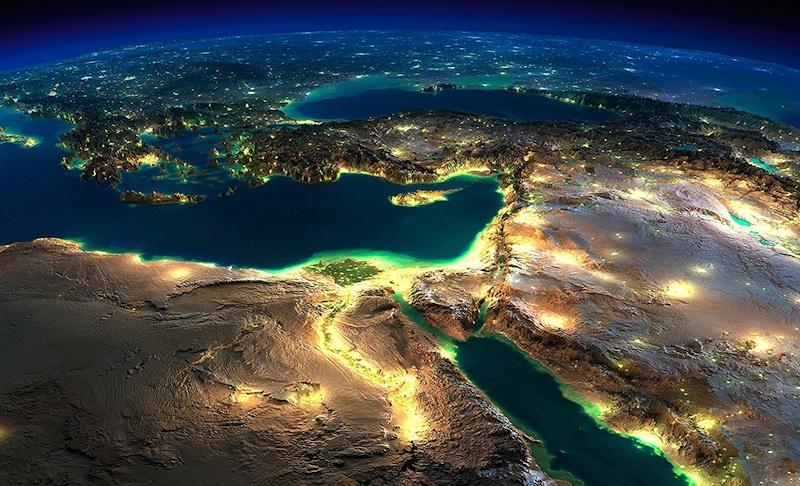Is Egypt’s Energy Hub Dream Falling Apart?
Authored by Cyril Widdershoven via OilPrice.com,
Since the end of the 1990s Egypt has dreamt of becoming an East Mediterranean gas and energy hub.
The discoveries offshore in the Nile Delta at the end of the 20st Century, that kickstarted the LNG boom sparked hope, but regional and internal conflicts which led to the removal of president Husni Mubarak and the rule of the Muslim Brotherhood have significantly slowed down the country’s energy industry.
However, new discoveries made in the last couple of years, combined with strong results offshore Cyprus, Israel and possibly even the coming years in Lebanon have brought new hope. The so-called East Med Gas Forum, in which most littoral states are participating is seen as one of the main drivers of new energy developments. Led by Egypt-Israel and the Greece-Cyprus quartet, a new start was made to reshape the region’s energy market, with as crown jewel, Egypt’s LNG liquefaction capacity in Idku and Damietta. The combined reserves of the participants, especially Egypt’s elephant-sized fields Zohr and Noor, combined with Israel’s offshore wealth, could supply the European market. The EU and even the U.S. promote the so-called East Med Offshore Gas Pipeline project connecting the East Mediterranean with the Balkans and possibly Italy. The region is optimistic and strategies are being implemented at a remarkable speed. Even with Turkish military and political obstruction constraining or even threatening some of the projects, progress is made.
However, politicians and energy operators have maybe underestimated the environment they are working in. A global gas glut is emerging, threatening not only LNG exporters such as Australia, Qatar, Mozambique and others, but also the East Med Energy Hub dreams of the EMGF. Some of the region’s projects are already facing headwinds.
In a remarkable move, Cairo has cancelled several tenders in 2019 as market prices offered were below expectations. Analysts stated that some bidders even offered prices which were below the break-even cost prices of production. Still, the members of the forum are not yet concerned at all it seems. Egypt believes that operational costs as its LNG plants should be very low, regarding the fact that the plants are already paid off, and all capacity is installed. If global LNG landing prices fall below Cairo’s production costs, the nation will have a real issue.
The position taken at present by the Egyptian oil ministry to sell LNG under term agreements with a target selling price of $5/MMBtu, rather than on the spot market, is a risky one. With a market able to get all volumes needed on the spot market, where prices are much lower, the real question is, if there will be any bidders interested in the prices as announced in the tender.
Globally prices have plummeted. Large Asian buyers such as China, Japan and South Korea are enjoying much lower prices. The JKM benchmark for Asian LNG spot prices has fallen by 50% since the beginning of 2019 from around $8/MMBtu to a little over $4/MMBtu. Long-term deals such as Egypt is offering are a risky proposition for any buyer. For example, selling an 18-month FOB deal at $5/MMBtu is very challenging at present. East Mediterranean nations can count on stiff competition from Qatar, Australia and others. And by now, most analysts expect that global gas and LNG markets will see a “lower for longer” price environment.
The coming months will be decisive for Egypt’s LNG industry. The only parties interested at present could be new entrants to the market, or parties looking for some structural deals. If these, however, are not available, Egypt and its East Med partners could be facing a scenario in which LNG exports will be low or maybe even non-existing.
In the meantime, Egypt’s gas production increase is impressive, the country produces more from its Zohr field than it can physically export. LNG exports from Egypt more than doubled year on year in 2019 to 4.8 Bcm of gas equivalent. On top of that, Cairo has started to import Israeli gas.
Egypt’s local market demand is still too low to absorb the current glut, and pipeline exports to Jordan are still very low. To counter the influx of Israeli gas (6 million cubic meter per year), Egypt is forced already to consider restarting its 2nd LNG plant in Damietta (5 million metric tons/year). A restart is currently being discussed by the operator Union Fenosa Gas (UFG), a 50-50 joint venture between Eni and Spain’s Naturgy.
The LNG global market glut situation needs to be addressed not only by Egypt but all EMGF parties the coming months. The immense volumes available now and need to be monetized soon. Egypt would do well to focus Eastern European markets (including the Balkans). In this market, it will have to find a way to compete with, Russia, Norway and Qatar. Price levels could be plummeting even further in the short term, so Cairo must make sure to sell its existing LNG inventory soon.
The Forum’s parties should take a realistic view on their offshore gas wealth, and dreaming about a major multibillion treasury trove like Qatar’s is maybe not realistic. A long-term vision is much needed, and Cairo needs to develop a clear understanding of its potential markets, which might not just be North or West, but possibly even in the East.
OPEC’s main oil producer, and Egyptian ally Saudi Arabia is still in dire need for additional gas volumes. Redirecting the former Arab Gas Pipeline (AGP), which was meant to export Egyptian gas to Jordan, Lebanon and Syria, to Saudi Arabia could be hitting two birds with one stone. Integrating regional energy and security while monetizing reserves.
Tyler Durden
Mon, 02/03/2020 – 03:30
via ZeroHedge News https://ift.tt/31qLSoP Tyler Durden

